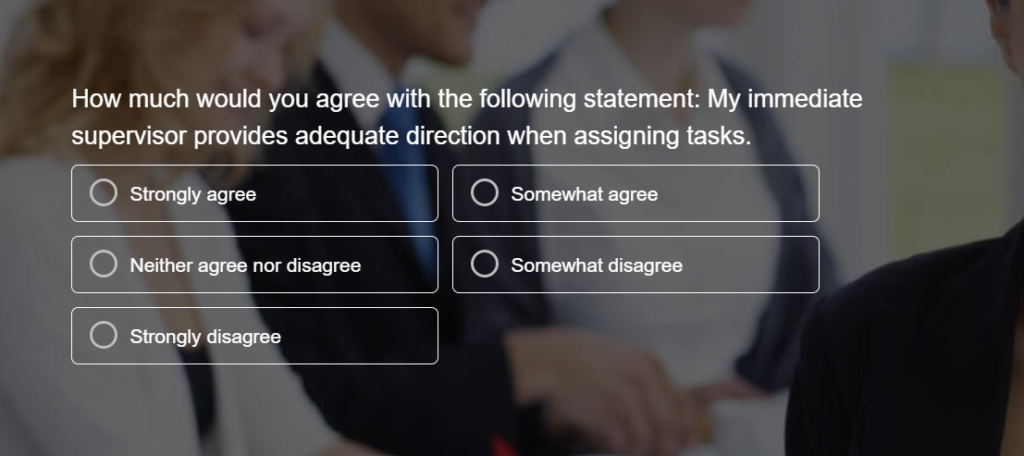
Leading a team is rewarding, but let’s face it—it’s not always easy.
As an organization, you may want to know if your leaders are truly connecting with your team or whether they are fostering an environment where employees can thrive.
This is where leadership survey questions can help you cut through the noise and get to the heart of what matters.
This blog breaks down what makes leadership questions crucial and offers 20+ examples of how to create an impactful leadership survey.
Let’s begin.
What Is a Leadership Survey?
A Leadership survey is a structured tool used by organizations to gain a clear picture of how leaders are perceived by their teams and peers.

These surveys gather detailed feedback on qualities essential to effective leadership, such as communication skills, decision-making abilities, emotional intelligence, accountability, and the capacity to motivate and inspire others.
Simply put, leadership surveys give organizations a clearer picture of:
- What’s working well in their leadership style, and what could be better.
- How leaders impact team morale, engagement, and productivity.
- Opportunities for growth, training, and leadership development.
- Creating a culture of transparency and open, constructive feedback.
Why Do You Need a Leadership Survey?
A leadership survey is a powerful way to help your organization and your leaders grow together. It’s all about giving employees a safe space to share honest feedback and helping leaders understand their impact on their teams.
Here’s why they’re so valuable:
Gain Honest Insights
Leadership surveys provide candid feedback on how leaders are perceived across various levels. This transparency is crucial for understanding real strengths and potential areas of improvement that may not be visible in day-to-day interactions.
Enhance Leadership Skills
By identifying specific areas where leaders can grow, these surveys serve as a roadmap for targeted development and coaching. This helps leaders build skills that are in alignment with the team’s and organization’s needs.
Boost Team Morale and Productivity
Effective leadership directly impacts team satisfaction and engagement. Surveys allow employees to feel heard, which, in turn, boosts morale, improves trust, and ultimately increases productivity.
Drive a Culture of Continuous Improvement
Regular feedback creates a cycle of improvement, encouraging leaders to adapt, grow, and respond to changing team dynamics. This supports a culture where learning and growth are embraced at every level.
Increase Retention
Positive leadership is one of the most significant factors in employee retention. By fostering an environment where leadership is responsive and supportive, organizations can reduce turnover and retain top talent.
20+ Must-Ask Survey Questions Related to Leadership
Here’s a list of questions to ask the leadership that can help you assess various aspects of leadership effectiveness, from communication and decision-making to emotional intelligence and team motivation.
I. Communication
- How effectively does your leader communicate team goals and expectations?
- Does your leader listen to and value team members’ input?
- How well does your leader communicate updates or changes that affect the team?
II. Decision-Making
- Does your leader involve the team in decision-making processes when appropriate?
- How confident are you in your leader’s ability to make informed decisions?
- Does your leader explain the rationale behind key decisions?
III. Support and Development
- How effectively does your leader support your professional growth and development?
- Does your leader encourage learning and provide opportunities to improve skills?
- How often does your leader provide constructive feedback that helps you improve?
IV. Motivation and Morale
- Does your leader foster a positive and motivating team environment?
- How well does your leader recognize and celebrate team or individual achievements?
- Does your leader help you feel engaged and valued within the team?
V. Trust and Integrity
- Do you feel comfortable approaching your leader with concerns or issues?
- How transparent is your leader about challenges or setbacks?
- Does your leader treat team members with fairness and respect?
VI. Emotional Intelligence
- Does your leader handle stress and challenges calmly and effectively?
- How well does your leader respond to the needs and concerns of team members?
- Does your leader show empathy and understanding in difficult situations?
VII. Alignment and Vision
- How effectively does your leader align team goals with the company’s vision and values?
- Does your leader inspire confidence in the team’s direction and purpose?
- How well does your leader communicate the bigger picture and the team’s role in it?
VIII. Feedback and Improvement
- How open is your leader to receiving feedback from the team?
- Does your leader actively work on self-improvement and growth based on feedback?
- How often does your leader encourage open and constructive feedback within the team?
What Are the Types of Leadership Surveys?
Leadership surveys aren’t a one-size-fits-all solution. Different types of surveys cater to specific needs and objectives, and here is an overview of some of the popular survey types:
- 360-Degree Leadership Survey: This comprehensive approach gathers feedback from a leader’s entire circle of influence: superiors, peers, and subordinates. It provides a holistic view of leadership effectiveness, highlighting strengths and blind spots from multiple perspectives.
- Leadership Style Assessment: This survey focuses on identifying a leader’s dominant leadership style, such as transformational, transactional, democratic, or laissez-faire. Understanding their style helps leaders leverage their strengths and adapt their approach to different situations.
- Leadership Skills Assessment: This type of survey evaluates specific leadership competencies, such as communication, decision-making, problem-solving, and delegation. It helps pinpoint areas where leaders excel and areas where they need further development.
- Team Effectiveness Survey: While focused on the team, this survey often includes questions about the leader’s role in fostering collaboration, communication, and productivity. It helps assess how leadership impacts team dynamics and overall performance.
- Organizational Culture Survey: This broader survey often includes questions about leadership’s impact on organizational culture, values, and employee engagement. It helps identify whether leadership is aligned with the desired organizational culture.
- Pulse Surveys: These short, frequent surveys provide quick snapshots of leadership effectiveness over time. They allow for ongoing feedback and enable leaders to track progress and make adjustments as needed.
Choosing the right type of leadership survey depends on several factors:
- Objectives: What specific insights are you hoping to gain?
- Audience: Who will be providing feedback?
- Scope: How broad or narrow do you want the focus to be?
- Resources: What time and budget constraints do you have?
By carefully considering these factors, organizations can select the most appropriate leadership survey to meet their needs and drive meaningful improvements.
FREE. All Features. FOREVER!
Try our Forever FREE account with all premium features!
How to Craft a Leadership Survey: Essential Strategies and Tips
Creating a leadership survey that delivers valuable insights requires careful planning and execution. Here’s a roadmap to guide you:
- Define Your Objectives:
- Start with a clear purpose. What do you hope to achieve with this survey? Are you trying to identify leadership gaps, assess specific skills, or measure the impact of leadership on organizational culture?
- Focus on specific areas. Avoid generic questions. Instead, tailor your survey to address the most critical leadership aspects within your organization.
- Choose the Right Survey Type:
- Align the survey type with your objectives. Do you need a 360-degree view, a leadership style assessment, or a pulse survey? (Refer to the “Types of Leadership Surveys” section for guidance.)
- Consider your audience and resources. Who will be participating, and what time and budget constraints do you have?
- Craft Effective Questions:
- Use a mix of question types. Include a variety of formats, such as rating scales, multiple-choice, and open-ended questions, to gather diverse perspectives.
- Keep questions concise and focused. Avoid jargon and ambiguity. Each question should be easy to understand and address a specific aspect of leadership.
- Ensure anonymity and confidentiality. Encourage honest feedback by assuring participants that their responses will remain anonymous.
- Pilot Test Your Survey:
- Get feedback before launch. Share the survey with a small group of individuals to identify any confusing questions or technical issues.
- Refine based on feedback. Use the pilot test results to improve the clarity, flow, and overall effectiveness of your survey.
- Launch and Promote:
- Communicate the survey’s purpose. Explain why you’re conducting the survey and how the feedback will be used.
- Ensure accessibility. Make the survey easily accessible to all participants, using a platform that is user-friendly and mobile-compatible.
- Set a clear deadline. Provide a reasonable timeframe for completion to encourage timely responses.
- Analyze and Act on the Results:
- Identify key trends and patterns. Look for recurring themes and areas of agreement or disagreement in the feedback.
- Share findings with leaders. Provide individualized reports that highlight their strengths and areas for development.
- Develop action plans. Use the data to create targeted leadership development programs and initiatives.
- Follow up and track progress. Monitor the impact of any changes implemented and conduct follow-up surveys to measure progress over time.
Tips for Crafting Engaging and Effective Questions:
- Focus on behaviors, not personality traits. Instead of asking, “Is the leader charismatic?” ask, “Does the leader inspire and motivate the team?”
- Use a consistent rating scale. This makes it easier to compare responses and identify trends.
- Include open-ended questions for deeper insights. These allow participants to provide detailed feedback and specific examples.
- Avoid leading questions. Ensure questions are neutral and don’t steer respondents toward a particular answer.
- Keep the survey concise. Respect participants’ time by avoiding overly long or repetitive questions.
The Best Times to Conduct Leadership Surveys
Here are some of the best times to conduct leadership surveys for meaningful, actionable insights:
- After Key Projects or Milestones: Conducting a survey after a major project or milestone helps capture fresh feedback on leadership performance during critical times. It’s an ideal moment to see how well leaders support their teams through challenges and achievements.
- During Annual or Semi-Annual Reviews: Including a leadership survey as part of performance reviews gives leaders a regular pulse check. This timing provides a broader, reflective view of leadership effectiveness over several months.
- Post-Leadership Changes: If there’s been a recent change in leadership roles, such as a new manager or restructuring, a survey can gauge how well the transition was managed and if the new leadership style meets the team’s needs.
- After Training or Development Programs: Conducting a survey after leaders complete training or coaching programs can help measure whether these initiatives led to improvements in leadership behavior and effectiveness.
- Mid-Year Check-Ins: A mid-year survey provides an opportunity to adjust and improve leadership approaches before the end of the year. It’s a proactive way to ensure leaders are continuously aligning with team and organizational goals.
- In Times of Significant Organizational Change: During times of change, like mergers, restructuring, or policy shifts, leadership can have a major impact on team morale. A survey during these times provides insight into how well leaders are guiding their teams through transitions.
- After Gathering Regular Employee Feedback: If your organization frequently conducts employee engagement surveys, follow up with a leadership survey. This helps pinpoint specific leadership practices that may be affecting engagement.
- End of the Fiscal Year: The end of the fiscal year is a great time to reflect on how well leadership has contributed to meeting annual goals and to set improvement areas for the coming year.
Empower Your Leadership with Insightful Feedback
Conducting regular, well-timed leadership surveys is a powerful way to ensure that your leaders have the feedback they need to grow and support their teams effectively.
By choosing the right moments to survey and asking the right questions, you can gather valuable insights into leadership performance, fostering a culture of continuous improvement and open communication.
With tools like ProProfs Survey Maker, creating and distributing leadership surveys is easier than ever. Customize your surveys, track results in real-time, and empower your organization with meaningful feedback that drives stronger, more cohesive teams.
Get started free, or get a demo now!
 Tips
Tips
We’d love to hear your tips & suggestions on this article!
FREE. All Features. FOREVER!
Try our Forever FREE account with all premium features!

 We'd love your feedback!
We'd love your feedback! Thanks for your feedback!
Thanks for your feedback!






